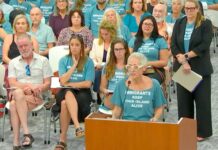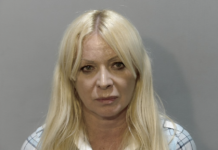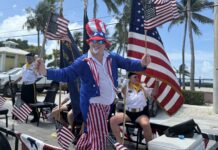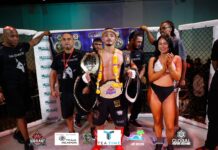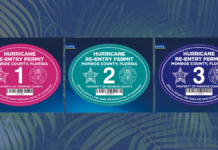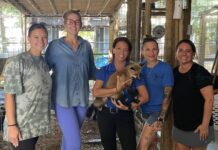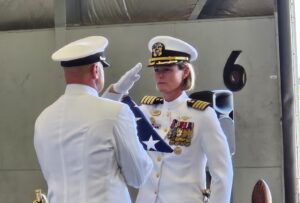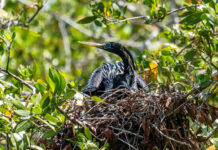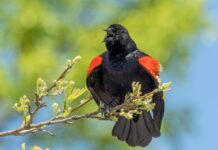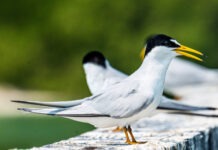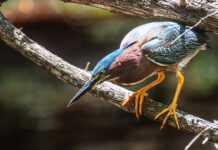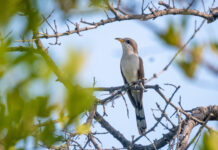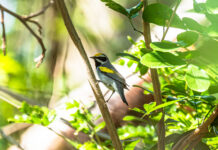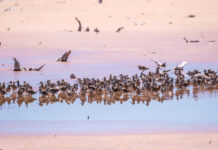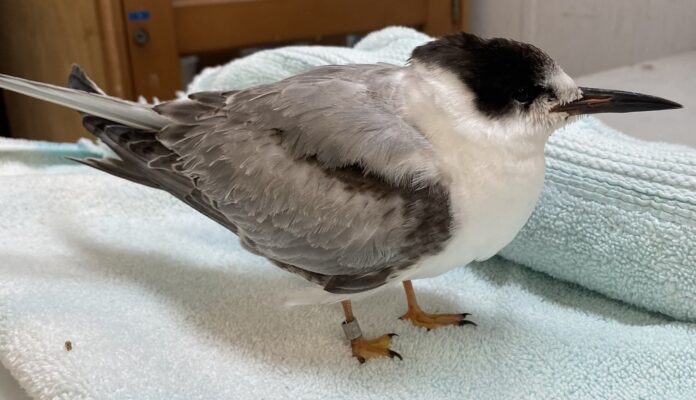
I was working hard on a “The Year In Birds” column. I had gotten as far as “January 2023” and needed a break. The mental energy it takes to produce this column can be exhausting. I’d post a link to the GoFundMe account I’ve set up to combat this mental fatigue, but the editors would just remove it again, as they always do, and I’d get another terse email from the Keys Weekly HR department telling me how it is “journalistically unethical” to prey on people’s empathy just so I can buy more expensive bourbon. But how, exactly, is self-care “journalistically unethical?” How? I ask you.
Anyhow, I went to Facebook, which is the single best way to not procrastinate, when I saw a photo Jim Hale posted.
A photo of a bird in Jim Hales’ hand is not uncommon. He’s a pigeon fancier, and used to keep a coop. And he’s kind of the go-to guy for reuniting other pigeon fanciers with homing pigeons that have de-homed themselves and strayed into the Lower Keys. He also ends up caring for a lot of the Cuban homing pigeons that show up here, which happens more often than you would think.
But this bird was a small tern, sleeker than a pigeon, with a similar wingspan but about half the body mass. It had an all dark bill about the size and shape of a BIC pen cap. It had a white belly, breast and forehead, but everything else was a grayish brown.
Tern identification can be tricky, especially with the small ones. From Jim’s photo I was thinking it might be a sooty tern, a species that breeds at the Dry Tortugas, or a bridled tern, which only breeds very rarely at the Dry Tortugas. Both are pelagic species that are seen pretty regularly offshore. But the dark parts of a sooty tern are black and the dark parts of a bridled tern are black or gray, and this bird was more brown. Brown plumage often means immature (see: white ibis) but immature sooties are kind of polka-dotted and immature bridles are kind of striated. This bird was neither.
The brownishness, though, might have just been a color cast of the photo.
Jim had seen the bird sitting in the parking lot at a marina and apparently thought it looked unwell. Catching a tern, even an unhealthy one, is no easy task. Unlike gulls, their trashier cousins, there’s not a lot in the human world, other than dock pilings, that attracts them, and they tend to be highly evasive. But Jim has an innate calm that animals tend to trust and he seemed to have scooped it up rather easily.
He said he was taking it to the Key West Wildlife Center.
Curiosity and deadline avoidance were getting the better of me, so I texted Peggy Koontz and asked if she could send me a few more photos, which she was kind enough to do, though I think partly because she wasn’t sure what species it was either.
The bird was banded, but, Peggy said, when she tried to enter the numbers into the U.S. Geological Survey’s Bird Banding Laboratory, it said the numbers weren’t in the system. That could mean the bird was a young one that had been banded this summer, and there had just been a lag in the data entry.
The bird looked much different standing on a table. There was no brown. There was the white belly, breast and forehead, but the cap was black, and its back and wings were gray, except for a band of darker feathers that contoured the leading edge of the folded wing. The bird also had orange legs.
The feathers looked disheveled, though, which often happens with unhealthy birds, but also can muddy the waters ID-wise.
The bird was in non-breeding plumage, which makes sense in the winter. Looking at the size, there were only four or five species it could be at this point. Flipping through Sibley’s I narrowed it down to three very similar possibilities – Forster’s tern, common tern, or roseate tern.
One of the field marks for common tern is a thing called a carpal bar, or a dark band of feathers that follow the contour of the leading edge of the wing, which this bird had. But in the field guide, when common terns have the plumage with the carpal bar, they have black legs. They only had orange legs in breeding plumage, when there was no carpal bar.
The Forster’s tern had orange legs year-round, but no carpal bar. The roseate tern had kind of orangey-red legs year-round, but also no carpal bar.
Field guides, even those as great as the Sibley guide, can’t always show all possibilities of what a species might look like, what with their parts changing color all the time as they transition between plumages. So I did a little Googling and found photos of common terns with carpal bars and orange legs at the same time.
Mystery solved. But it’s a fine line between confidence and hubris, so I texted the photos to my bird savant friend, Rafael Galvez. He got back to me pretty quickly, pointing out that birds transitioning between plumages can have some crazy combinations. Also, he’d seen carpal bars on roseate terns before, so that didn’t rule them out. Arrrgh.
But he added that from the photo I sent, even though most of the tail was cropped out, it looked like the two outer tail feathers were darker than the inner tail feathers, and if that was the case, it would clinch it for common tern.
I sent him one of the other photos, with more tail in it, and the outer tail feathers were, in fact, darker. He also said all the dark flight feathers were also indicative. So common tern. Almost certainly. Hopefully someday the band number will confirm this.
I texted Peggy, telling her that we were pretty sure it was a common tern, and asking how the bird was doing. She said it was very weak and its feathers were full of lice, which happens if a bird is unable to groom itself well enough. But the bird was warmed up now, and had even managed to eat a few small, live fish.
Peggy said she was hopeful the bird will continue to improve. As am I. I’d much rather be confused by a bird like that in the wild.

